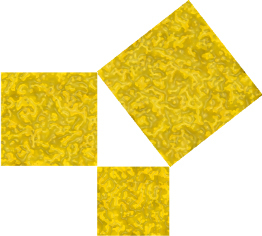Module 6
1. Module 6
1.25. Page 5
Module 6: Triangles and Other Polygons
Lesson Summary

In his book 5000 BC and Other Philosophical Fantasies, the mathematician Raymond Smullyan describes a puzzle he would put to his students. Squares of beaten gold are placed on the three sides of a right triangle as shown in the illustration. You can either choose the large square or you can choose both of the two smaller squares. Which would you choose?
In this lesson, you explored the following questions.
-
What is the Pythagorean Theorem, and how can the theorem be verified?
-
What are the current and historical applications of the Pythagorean Theorem?
To answer these questions, you investigated the 3-4-5 right triangle, its application as a surveyor’s tool in Ancient Egypt, and its use today in modern carpentry. You discovered that this triangle is a special instance of the Pythagorean theorem. You explored one proof attributed to the Chinese over three thousand years ago! In the next lesson you will explore this theorem further in its application to a variety of everyday problems.
Check your level of understanding of the materials covered in this lesson by completing “Lesson 5 Traffic Lights.” If you select an amber or red traffic light in the multimedia piece, you will receive information about additional work you can complete to improve your understanding of the topics. Complete the suggested work before you proceed to the Lesson 5 Assignment. If you experience difficulty, contact your teacher before starting the Lesson 5 Assignment.
 Assignment
Assignment
Retrieve the Lesson 5 Assignment Booklet you saved in your course folder at the start of this lesson. Complete the Assignment Booklet. Resave your Assignment Booklet in your course folder and submit a copy to your teacher for assessment.